Developers now rely on cloud infrastructure automation tools to manage their complex systems—and manual resource handling simply can't keep up as projects expand.As a user on Reddit says, “Much of DevOps is about the right tool in the right place.”But, which cloud infrastructure automation tool or combination of tools should you pick? There are quite a few of them on the market.And you just can’t test all the tools out there—you need to set them up according to your cloud infrastructure, then give a few of your team members access to test the tool, and keep trying until you find one that works best.Instead, let’s simplify that.## The 10 Best Cloud Infrastructure Automation Tools
We analyzed 10 of the most popular tools in the cloud infrastructure industry by connecting with people across the web who already use these tools and talk about them publicly, so you get a better perspective of the market!### 1. Terraform
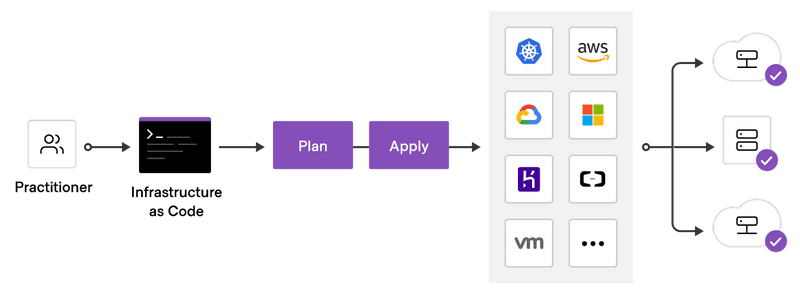 SourceHashiCorp developed Terraform to make building and managing infrastructure easier. Terraform, an open-source tool uses either HashiCorp Configuration Language (HCL) or JSON. you can think of Terraform as a language for code your infrastructure.This "Infrastructure as Code" approach (IaC) means managing your infrastructure through code, leading to greater consistency and efficiency. Your infrastructure becomes repeatable and manageable.“Terraform allows me to build AWS resources in a repeatable, documented way, just like source code or a Jupyter notebook allows you to create a programmatic solution in a repeatable, documented way.” u/ReturnOfNogginboink#### Key Features:
****Declarative configuration language (HCL) for resource definitionSupport for multiple cloud providers and on-premises infrastructureState management for tracking real-world resourcesPlan and apply workflow for reviewing changes before implementationModular architecture for reusable infrastructure componentsTerraform's provider-agnostic approach gives developers the flexibility to work across different cloud platforms using a consistent workflow. This can be particularly valuable for organizations with multi-cloud strategies or those looking to avoid vendor lock-in.#### Considerations:
Excellent for multi-cloud and hybrid environmentsState management requires careful handling, especially in collaborative settingsLearning curve can be significant for complex infrastructuresCommunity support and resource availability are strong### 2. AWS CloudFormation
SourceHashiCorp developed Terraform to make building and managing infrastructure easier. Terraform, an open-source tool uses either HashiCorp Configuration Language (HCL) or JSON. you can think of Terraform as a language for code your infrastructure.This "Infrastructure as Code" approach (IaC) means managing your infrastructure through code, leading to greater consistency and efficiency. Your infrastructure becomes repeatable and manageable.“Terraform allows me to build AWS resources in a repeatable, documented way, just like source code or a Jupyter notebook allows you to create a programmatic solution in a repeatable, documented way.” u/ReturnOfNogginboink#### Key Features:
****Declarative configuration language (HCL) for resource definitionSupport for multiple cloud providers and on-premises infrastructureState management for tracking real-world resourcesPlan and apply workflow for reviewing changes before implementationModular architecture for reusable infrastructure componentsTerraform's provider-agnostic approach gives developers the flexibility to work across different cloud platforms using a consistent workflow. This can be particularly valuable for organizations with multi-cloud strategies or those looking to avoid vendor lock-in.#### Considerations:
Excellent for multi-cloud and hybrid environmentsState management requires careful handling, especially in collaborative settingsLearning curve can be significant for complex infrastructuresCommunity support and resource availability are strong### 2. AWS CloudFormation
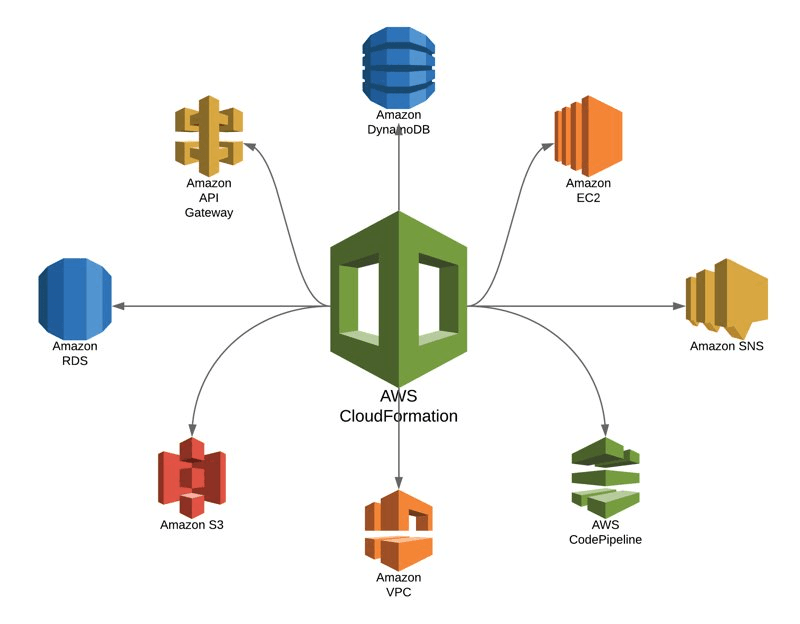 SourceAWS CloudFormation is Amazon's native infrastructure as code (IaC) service, designed specifically for automating AWS resource management. It helps developers to define and provision AWS infrastructure using declarative templates.“CloudFormation has a much lower barrier of entry, which makes it much much better for simple stuff." — u/Noform5443#### Key Features:
Template-based resource definition using JSON or YAMLAutomated provisioning and updates of AWS resourcesStack management for grouping related resourcesBuilt-in rollback capabilities for failed operationsTight integration with other AWS servicesAWS recently made CloudFormation faster reporting up to 40% faster stack creation times. This is a big improvement for developers working with large-scale infrastructure.Teams already using AWS greatly benefit from CloudFormation because it integrates so well with other AWS services. It becomes especially helpful for managing complex, interconnected resources within a single stack. However, there is a learning curve, especially for those new to IaC.“CloudFormation isn't a perfect tool, but it generally works well enough. Most complaints have to do with a few quirks and it being too verbose” — u/clintkev251#### Considerations:
CloudFormation works best in environments focused on AWS services.Compared to other IaC tools, CloudFormation can take longer to learn.For complex infrastructures, templates can become long and difficult to read.CloudFormation isn't very useful outside the AWS ecosystem.### 3. Ansible
SourceAWS CloudFormation is Amazon's native infrastructure as code (IaC) service, designed specifically for automating AWS resource management. It helps developers to define and provision AWS infrastructure using declarative templates.“CloudFormation has a much lower barrier of entry, which makes it much much better for simple stuff." — u/Noform5443#### Key Features:
Template-based resource definition using JSON or YAMLAutomated provisioning and updates of AWS resourcesStack management for grouping related resourcesBuilt-in rollback capabilities for failed operationsTight integration with other AWS servicesAWS recently made CloudFormation faster reporting up to 40% faster stack creation times. This is a big improvement for developers working with large-scale infrastructure.Teams already using AWS greatly benefit from CloudFormation because it integrates so well with other AWS services. It becomes especially helpful for managing complex, interconnected resources within a single stack. However, there is a learning curve, especially for those new to IaC.“CloudFormation isn't a perfect tool, but it generally works well enough. Most complaints have to do with a few quirks and it being too verbose” — u/clintkev251#### Considerations:
CloudFormation works best in environments focused on AWS services.Compared to other IaC tools, CloudFormation can take longer to learn.For complex infrastructures, templates can become long and difficult to read.CloudFormation isn't very useful outside the AWS ecosystem.### 3. Ansible
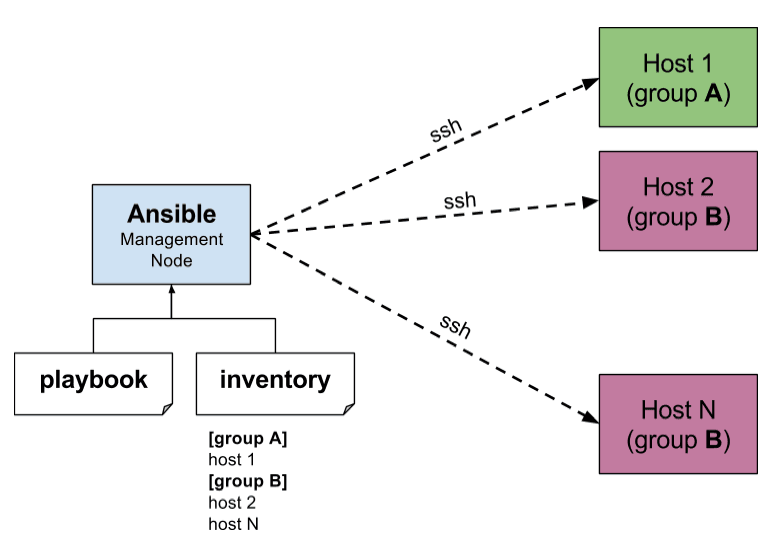 Ansible is popular among developers for its simplicity and versatility in terms of automating IT infra tasks among others. Ansible also helps with provisioning automation and configuration management.“Ansible works by connecting to nodes (or hosts) and pushing out small programs—called modules—to these nodes. Modules are used to accomplish automation tasks in Ansible” — Red Hat foundation#### Key Features:
Agentless architecture using SSH for remote executionYAML-based playbooks for defining automation tasksExtensive module library covering a wide range of systems and servicesSupport for multiple operating systems and cloud providersAd-hoc command execution for quick tasksAnsible's straightforward YAML syntax and agentless design make it accessible to developers who may be new to infrastructure automation. Its flexibility allows it to be used for a variety of tasks beyond just cloud infrastructure, including application deployment and system configuration.The Ansible community emphasizes readability and simplicity in automation design, which aligns well with DevOps practices focused on collaboration and shared responsibility.#### Considerations:
“If you're fully containerized and using managed k8s ansible probably won't add a lot of value for you.” — u/Mr_MarsWell-suited for heterogeneous environments (cloud + on-premises)Can become complex to manage for very large-scale deploymentsPerformance can be a concern for tasks requiring high concurrencyMay require additional tools for stateful infrastructure management### 4. Facets
Ansible is popular among developers for its simplicity and versatility in terms of automating IT infra tasks among others. Ansible also helps with provisioning automation and configuration management.“Ansible works by connecting to nodes (or hosts) and pushing out small programs—called modules—to these nodes. Modules are used to accomplish automation tasks in Ansible” — Red Hat foundation#### Key Features:
Agentless architecture using SSH for remote executionYAML-based playbooks for defining automation tasksExtensive module library covering a wide range of systems and servicesSupport for multiple operating systems and cloud providersAd-hoc command execution for quick tasksAnsible's straightforward YAML syntax and agentless design make it accessible to developers who may be new to infrastructure automation. Its flexibility allows it to be used for a variety of tasks beyond just cloud infrastructure, including application deployment and system configuration.The Ansible community emphasizes readability and simplicity in automation design, which aligns well with DevOps practices focused on collaboration and shared responsibility.#### Considerations:
“If you're fully containerized and using managed k8s ansible probably won't add a lot of value for you.” — u/Mr_MarsWell-suited for heterogeneous environments (cloud + on-premises)Can become complex to manage for very large-scale deploymentsPerformance can be a concern for tasks requiring high concurrencyMay require additional tools for stateful infrastructure management### 4. Facets
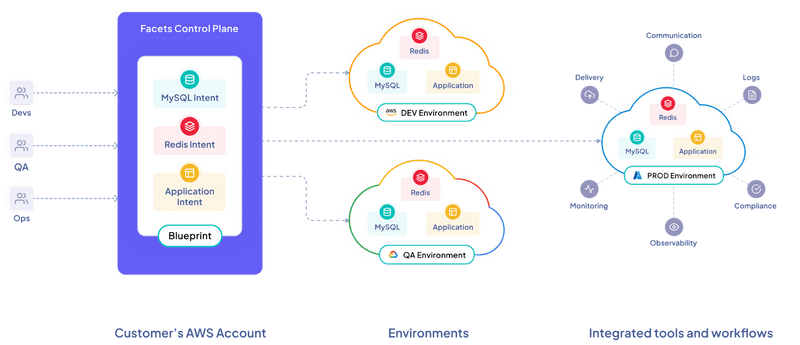 SourceFacets is a no-code infrastructure automation platform that helps you deploy cloud and infrastructure automation using Terraform, without writing Terraform code. While it started as an enterprise-only product, Facets is now focused on startups and early-stage developers who want to fast-track their way to create robust infrastructure automation and get their foundation setup before they scale.#### Key features:
Drag-and-drop interface to help developers write Terraform code without deep Ops knowledgePre-configured continuous deployment (CD) pipelines with best practices integratedRemoves the complexities involved in creating seamless multi-region and multi-tenant setupsBuilt-in tools for observability, security, and compliance are pre-configuredChanges in software or infrastructure are managed at the architectural level, which cascades to the environments, maintaining consistency and reducing tech debtFacets simplifies infrastructure automation, which otherwise would require having an Ops team onboard configuring everything from scratch. With the industry best practices baked into the platform, you can simply put the pieces of your infrastructure together to get your CI/CD pipelines ready and then onboard Ops experts to manage and improve upon the setup.#### Key considerations:
Perfectly suited if you are just setting up your cloud infrastructureRequires some upfront effort to integrate with an existing stackWhile Facets supports most toolchains, custom tools will require developer involvement. However, once the integration is coded, it can be reused in all your infra-automation setups.### 5. Puppet
SourceFacets is a no-code infrastructure automation platform that helps you deploy cloud and infrastructure automation using Terraform, without writing Terraform code. While it started as an enterprise-only product, Facets is now focused on startups and early-stage developers who want to fast-track their way to create robust infrastructure automation and get their foundation setup before they scale.#### Key features:
Drag-and-drop interface to help developers write Terraform code without deep Ops knowledgePre-configured continuous deployment (CD) pipelines with best practices integratedRemoves the complexities involved in creating seamless multi-region and multi-tenant setupsBuilt-in tools for observability, security, and compliance are pre-configuredChanges in software or infrastructure are managed at the architectural level, which cascades to the environments, maintaining consistency and reducing tech debtFacets simplifies infrastructure automation, which otherwise would require having an Ops team onboard configuring everything from scratch. With the industry best practices baked into the platform, you can simply put the pieces of your infrastructure together to get your CI/CD pipelines ready and then onboard Ops experts to manage and improve upon the setup.#### Key considerations:
Perfectly suited if you are just setting up your cloud infrastructureRequires some upfront effort to integrate with an existing stackWhile Facets supports most toolchains, custom tools will require developer involvement. However, once the integration is coded, it can be reused in all your infra-automation setups.### 5. Puppet
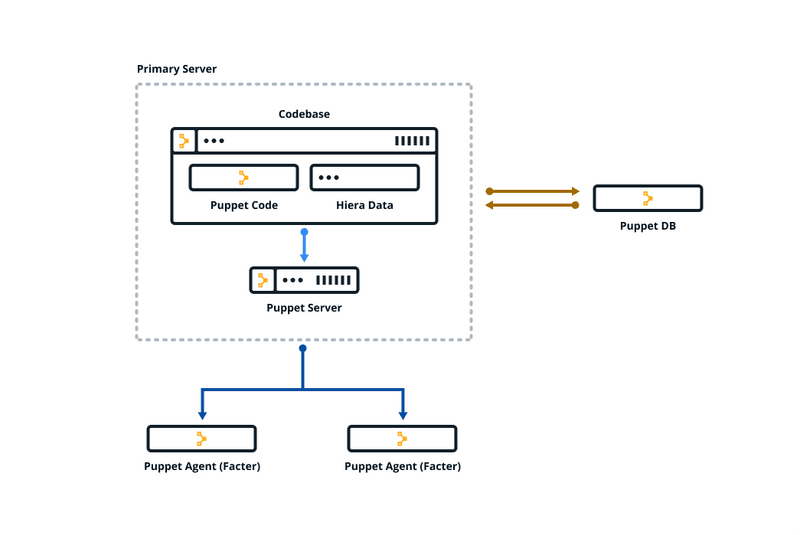 SourcePuppet is a well-known configuration management tool that simplifies how you manage and deploy your infrastructure. Puppet helps system admins define the desired state of their systems using declarative language ensuring that the systems remain in the designed and defined state.#### Key Features:
Puppet uses declarative language to help you write clearly defined configuration filesYou can use this in both agent-based and agentless setupsThe community contributes to a module forge, so you can find configurations others have already builtReporting and compliance built into the platformWorks seamlessly with different cloud providers and on-premises systems.Puppet's long history in configuration management makes it a reliable choice for organizations with complex infrastructure needs that they manage over the long term. Puppet uses a declarative approach to define system states, fitting well with infrastructure-as-code principles.Newer versions of Puppet offer better cloud integration, which makes Puppet more competitive in the infrastructure automation market.#### Considerations:
It works well for managing large-scale infrastructure over the long term.Puppet has a steeper learning curve than some newer tools.It excels at configuration management but might require other tools for certain infrastructure provisioning tasks.Puppet has many modules available that can speed up development.### 6. Chef
SourcePuppet is a well-known configuration management tool that simplifies how you manage and deploy your infrastructure. Puppet helps system admins define the desired state of their systems using declarative language ensuring that the systems remain in the designed and defined state.#### Key Features:
Puppet uses declarative language to help you write clearly defined configuration filesYou can use this in both agent-based and agentless setupsThe community contributes to a module forge, so you can find configurations others have already builtReporting and compliance built into the platformWorks seamlessly with different cloud providers and on-premises systems.Puppet's long history in configuration management makes it a reliable choice for organizations with complex infrastructure needs that they manage over the long term. Puppet uses a declarative approach to define system states, fitting well with infrastructure-as-code principles.Newer versions of Puppet offer better cloud integration, which makes Puppet more competitive in the infrastructure automation market.#### Considerations:
It works well for managing large-scale infrastructure over the long term.Puppet has a steeper learning curve than some newer tools.It excels at configuration management but might require other tools for certain infrastructure provisioning tasks.Puppet has many modules available that can speed up development.### 6. Chef
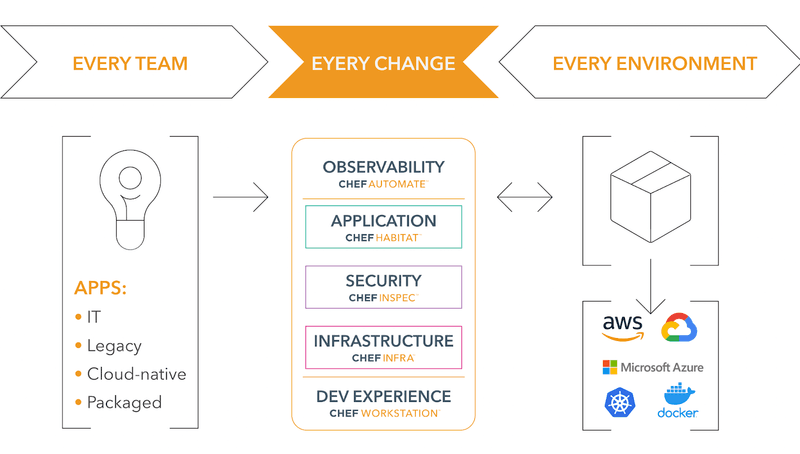 SourceChef.io excels at managing and deploying infrastructure as code. It's a powerful configuration management and automation platform. You can easily ensure that every machine in your environment adheres to predefined specifications and stays consistent. This capability shines in large-scale environments where configuration drift can cause havoc.#### Key Features:
Ruby-based domain-specific language (DSL) for defining your infrastructureEasily test your infrastructure's development every step of the wayA large library of pre-built configurations, called cookbooks, is ready to use and customizeChef supports both agent-based and agentless executionEasily integrates with all the popular cloud platformsChef's programmability attracts developers because it uses a familiar test-driven approach. They can manage infrastructure using software development practices, which often results in more reliable and maintainable automation code.Chef's approach to infrastructure as code fits well with continuous integration and delivery practices making it a strong choice for organizations adopting DevOps methodologies.#### Considerations:
Powerful for complex, code-driven infrastructure automationSteeper learning curve, especially for those new to RubyStrong in configuration management and application deploymentMay be overkill for simpler infrastructure needs### 7. SaltStack (Salt)
SourceChef.io excels at managing and deploying infrastructure as code. It's a powerful configuration management and automation platform. You can easily ensure that every machine in your environment adheres to predefined specifications and stays consistent. This capability shines in large-scale environments where configuration drift can cause havoc.#### Key Features:
Ruby-based domain-specific language (DSL) for defining your infrastructureEasily test your infrastructure's development every step of the wayA large library of pre-built configurations, called cookbooks, is ready to use and customizeChef supports both agent-based and agentless executionEasily integrates with all the popular cloud platformsChef's programmability attracts developers because it uses a familiar test-driven approach. They can manage infrastructure using software development practices, which often results in more reliable and maintainable automation code.Chef's approach to infrastructure as code fits well with continuous integration and delivery practices making it a strong choice for organizations adopting DevOps methodologies.#### Considerations:
Powerful for complex, code-driven infrastructure automationSteeper learning curve, especially for those new to RubyStrong in configuration management and application deploymentMay be overkill for simpler infrastructure needs### 7. SaltStack (Salt)
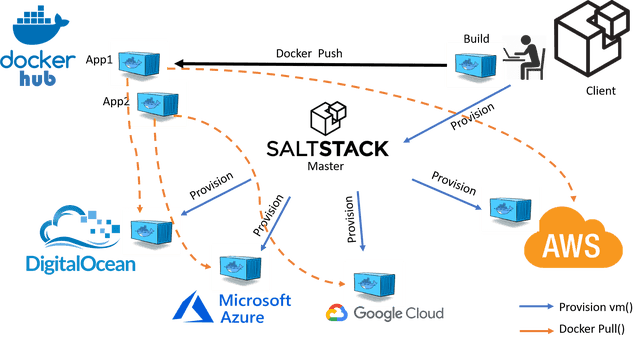 SourceSaltStack, simply called Salt, gives you the power to control and automate how you set up your computer systems. Think of it as a system with a master server giving commands to minion servers. Security is key, and Salt uses AES encryption and public-key authentication to make sure all communication between the master and minions stays private.#### Key Features:
An event-driven automation architecture allows for a flexible and responsive system.Supports both agent-based and agentless execution providing you the flexibility to manage infraModular design welcomes expansions, accommodating your needs as they evolveRemote execution at scale helps simplify the management of large, distributed systemsConfiguration management and orchestration capabilities further streamline the process of automating complex workflowsSalt's event-driven design and speed make it great for handling lots of servers quickly. This means it works well for simple jobs like managing one server or for complicated ones like coordinating a whole network.You can add new features to Salt easily because it's built in a modular way. This helps customize it, but it can also make Salt more complex to use.#### Considerations:
Handles large-scale deployments that demand swift execution.Flexible allowing you to manage various infrastructure tasks effectivelyTeams working with simpler infrastructures or smaller groups might find its setup and management somewhat complexIts documentation and community resources are less developed compared to other tools### 8. Jenkins
SourceSaltStack, simply called Salt, gives you the power to control and automate how you set up your computer systems. Think of it as a system with a master server giving commands to minion servers. Security is key, and Salt uses AES encryption and public-key authentication to make sure all communication between the master and minions stays private.#### Key Features:
An event-driven automation architecture allows for a flexible and responsive system.Supports both agent-based and agentless execution providing you the flexibility to manage infraModular design welcomes expansions, accommodating your needs as they evolveRemote execution at scale helps simplify the management of large, distributed systemsConfiguration management and orchestration capabilities further streamline the process of automating complex workflowsSalt's event-driven design and speed make it great for handling lots of servers quickly. This means it works well for simple jobs like managing one server or for complicated ones like coordinating a whole network.You can add new features to Salt easily because it's built in a modular way. This helps customize it, but it can also make Salt more complex to use.#### Considerations:
Handles large-scale deployments that demand swift execution.Flexible allowing you to manage various infrastructure tasks effectivelyTeams working with simpler infrastructures or smaller groups might find its setup and management somewhat complexIts documentation and community resources are less developed compared to other tools### 8. Jenkins
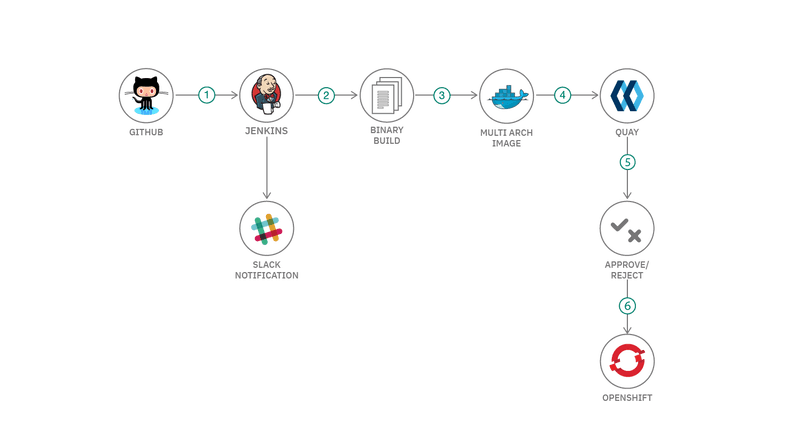 SourceJenkins is an open-source automation server that powers continuous integration and delivery for software projects. It quickly became an essential tool in DevOps after forking from Hudson in 2011. Its adaptability, expandability, and strong community support set it apart.Think of Jenkins as your robotic assistant. Every time you change your code, Jenkins builds and tests it, catching errors quickly and releasing updates faster.#### Key Features:
A rich plugin system allows you to connect all of your existing tools and services.Build processes are flexible and efficient with support for both declarative and scripted pipelines.Easily manage large projects with distributed build capabilities for scaling.Automate even highly complex tasks with customizable workflows.Seamlessly integrate with major cloud providers and infrastructure tools to guarantee efficient and scalable builds.Jenkins has improved its pipeline features and user interface in recent versions. These improvements address user complaints. However, managing large Jenkins installations and keeping plugins up-to-date remains a challenge.#### Considerations:
Jenkins shines when you integrate infrastructure automation into your CI/CD workflowsWhile it offers high customizability, it can lead to complexity, especially in large installationsMaintaining and securing Jenkins, particularly with many plugins, can require significant effortJenkins has a strong community and extensive documentation to help you along the way### 9. Google Cloud Deployment Manager
SourceJenkins is an open-source automation server that powers continuous integration and delivery for software projects. It quickly became an essential tool in DevOps after forking from Hudson in 2011. Its adaptability, expandability, and strong community support set it apart.Think of Jenkins as your robotic assistant. Every time you change your code, Jenkins builds and tests it, catching errors quickly and releasing updates faster.#### Key Features:
A rich plugin system allows you to connect all of your existing tools and services.Build processes are flexible and efficient with support for both declarative and scripted pipelines.Easily manage large projects with distributed build capabilities for scaling.Automate even highly complex tasks with customizable workflows.Seamlessly integrate with major cloud providers and infrastructure tools to guarantee efficient and scalable builds.Jenkins has improved its pipeline features and user interface in recent versions. These improvements address user complaints. However, managing large Jenkins installations and keeping plugins up-to-date remains a challenge.#### Considerations:
Jenkins shines when you integrate infrastructure automation into your CI/CD workflowsWhile it offers high customizability, it can lead to complexity, especially in large installationsMaintaining and securing Jenkins, particularly with many plugins, can require significant effortJenkins has a strong community and extensive documentation to help you along the way### 9. Google Cloud Deployment Manager
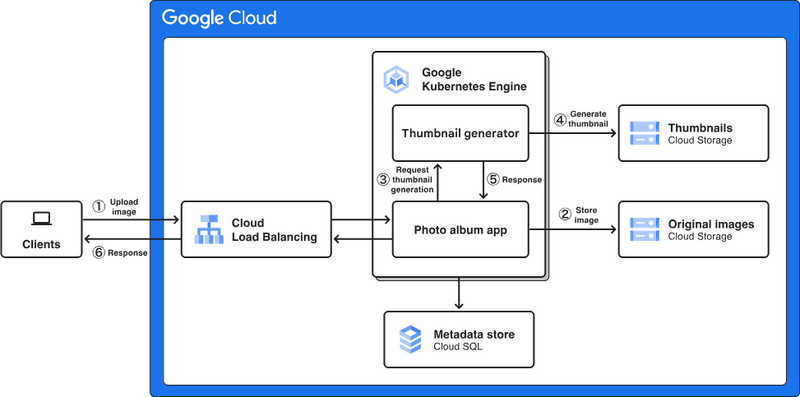 SourceGoogle Cloud Deployment Manager helps users automate cloud resource creation and management. As the name suggests, it is designed to integrate perfectly with the Google ecosystem and will be extremely beneficial if you use Google Cloud for your deployments.#### Key Features:
Uses YAML for configuration, with support for Python or Jinja2 templatesTight integration with other GCP servicesVersion control and templating for reusable configurationsPreview capabilities for reviewing changes before deploymentBuilt-in dependency management for GCP resourcesDeployment Manager’s preview capabilities help developers catch potential issues before applying changes, which can be particularly valuable in complex interconnected environments.#### Considerations:
Best suited for organizations with GCP-centric environmentsNot as flexible with multi-cloud setups compared to other provider-agnostic toolsMay require additional tools or custom development for advanced scenarios### 10. Pulumi
SourceGoogle Cloud Deployment Manager helps users automate cloud resource creation and management. As the name suggests, it is designed to integrate perfectly with the Google ecosystem and will be extremely beneficial if you use Google Cloud for your deployments.#### Key Features:
Uses YAML for configuration, with support for Python or Jinja2 templatesTight integration with other GCP servicesVersion control and templating for reusable configurationsPreview capabilities for reviewing changes before deploymentBuilt-in dependency management for GCP resourcesDeployment Manager’s preview capabilities help developers catch potential issues before applying changes, which can be particularly valuable in complex interconnected environments.#### Considerations:
Best suited for organizations with GCP-centric environmentsNot as flexible with multi-cloud setups compared to other provider-agnostic toolsMay require additional tools or custom development for advanced scenarios### 10. Pulumi
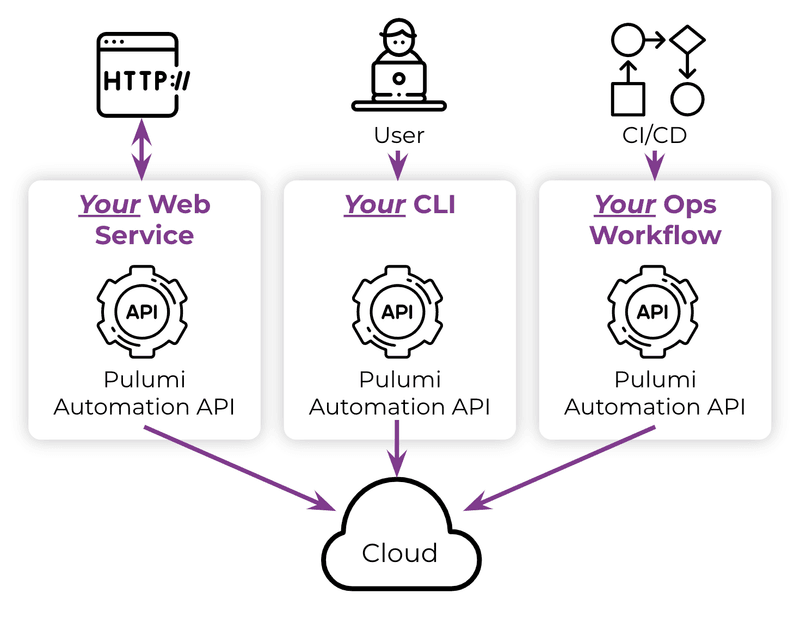 SourcePulumi's innovative approach to infrastructure as code lets you work with programming languages you already know, rather than forcing you to learn domain-specific languages or templating formats from scratch.#### Key Features:
Supports multiple programming languages, including JavaScript, TypeScript, Python, Go, and .NETProvides a consistent programming model across multiple cloud providersHandles state management and concurrency control for youYou can define policies as code to enforce governance and complianceUses strong typing and IDE support for catching errors earlyThe tool's support for strong typing and modern development practices like unit testing can lead to more robust and maintainable infrastructure code. However, it may require a mindset shift for teams accustomed to more traditional IaC approaches.#### Considerations:
Powerful for teams who want to use their existing programming skills to manage infrastructureLets you build complex, programmatic infrastructure definitionsMay have a steeper learning curve if you do not have a programming backgroundNewer than some other infrastructure tools, but is gaining traction## Choose the Right Tool for Your Cloud Infrastructure Automation
Automation tools help you manage complex cloud systems effectively. And no-code platforms like Facets let you start automating your infrastructure quickly without the overhead of hiring and learning new technologies when you’re just starting out.It simplifies Terraform deployment and applies industry best practices, enabling your team to set up robust automation rapidly.Facets proves especially useful for early-stage development teams looking to streamline their cloud setup process.Want to try a new way of building infrastructure automation? Sign up for a free trial and experience how no-code can speed up your progress!
SourcePulumi's innovative approach to infrastructure as code lets you work with programming languages you already know, rather than forcing you to learn domain-specific languages or templating formats from scratch.#### Key Features:
Supports multiple programming languages, including JavaScript, TypeScript, Python, Go, and .NETProvides a consistent programming model across multiple cloud providersHandles state management and concurrency control for youYou can define policies as code to enforce governance and complianceUses strong typing and IDE support for catching errors earlyThe tool's support for strong typing and modern development practices like unit testing can lead to more robust and maintainable infrastructure code. However, it may require a mindset shift for teams accustomed to more traditional IaC approaches.#### Considerations:
Powerful for teams who want to use their existing programming skills to manage infrastructureLets you build complex, programmatic infrastructure definitionsMay have a steeper learning curve if you do not have a programming backgroundNewer than some other infrastructure tools, but is gaining traction## Choose the Right Tool for Your Cloud Infrastructure Automation
Automation tools help you manage complex cloud systems effectively. And no-code platforms like Facets let you start automating your infrastructure quickly without the overhead of hiring and learning new technologies when you’re just starting out.It simplifies Terraform deployment and applies industry best practices, enabling your team to set up robust automation rapidly.Facets proves especially useful for early-stage development teams looking to streamline their cloud setup process.Want to try a new way of building infrastructure automation? Sign up for a free trial and experience how no-code can speed up your progress!
Back to all blogs
 Ayush Verma• Engineering•September 27, 2024•11 min read
Ayush Verma• Engineering•September 27, 2024•11 min read
cloud-nativeautomation
10 Best Cloud Infrastructure Automation Tools in 2024
Top 11 cloud infrastructure automation tools 2024. Automate cloud management, enhance efficiency, optimize infrastructure with the best automation tools.
#cloud-infrastructure#cloud-automation